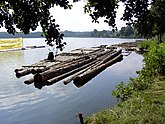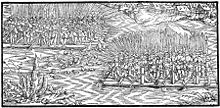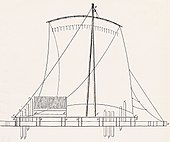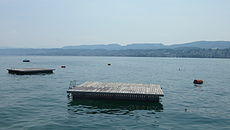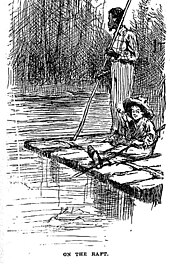raft
A raft (Pl .: rafts ) is a simple watercraft for transporting living beings or material.
The raft has no hull and is usually driven by the current when rafting . Usually, rafts used on large inland waterways have the shape of a plate without any noteworthy superstructures. When building rafts, wood (such as balsa wood ) is used locally in the form of whole trunks, rushes , reeds or hollow bodies (e.g. barrels).
Any drives on board a raft ( paddles , belts , motors , sails , stakes , etc.) mostly only serve to steer or keep it in the current, and only rarely to propel the raft forward . The purpose of a raft can be to transport felled tree trunks in an orderly manner.
history
Older rafts are hard to find. A raft from the Viking Age was found on the Elisenhof near Tönning in the North Friesland district in Schleswig-Holstein . The most famous raft in world history is the one built from parts of the frigate La Méduse . It sank off the coast of Senegal in 1816 . The tow ropes between the privately owned lifeboats and the 8 × 15 meter raft were cut. Of the 149 people on the raft, only 15 survived. The event caused a major political scandal and influenced Théodore Géricault in his famous painting The Raft of Medusa .
In 1445 the Schwyz used two covered rafts with 400 to 600 men, called Kiel and Gans, against the city of Rapperswil, which was in alliance with Zurich and Austria . The largest raft was equipped with a cannon and rifles that fired wooden bullets. For their part, the people of Zurich opposed their own rafts. The 800-man battle castle Bär in Zurich was 120 feet long and was also equipped with a cannon and rifle stands. In the seven-hour naval battle off Männedorf on October 29, 1445, large rafts manned with infantry were used alongside ships on both sides .
According to the Guinness Book of Records, the world's largest raft was built on August 29, 2009 in Potsdam . It consisted of 66 individual rafts, carried 303 people and was 594 square meters in size. The 3 × 3 meter single rafts were built from 5 planks, 13 boards and 5 ropes each. Eight truck hoses each served as buoyancy . The initiator of this campaign was the Brandenburg RBB radio station Radioeins and the organizer Teamgeist GmbH.
South American raft
A Peruvian raft differs in many ways from what Europeans understand by a raft.
The coastal Indians of Peru used rafts to carry heavy loads over long distances at sea. Goods up to a weight of 30 tons and up to 20 seafarers as well as their food could be transported along the entire coast of Peru - around 2500 kilometers - and at least as far as northern Ecuador . The length of a raft was up to 30 meters, the width up to 10 meters.
The building material is freshly felled balsa wood, the sap in the tree trunk prevents the ingress of seawater and keeps it buoyant for about two years. A raft usually consists of five, seven, nine or eleven tree trunks, the longest in the middle, getting shorter and shorter towards the outside. They are also beveled to reduce water resistance. The logs are held together by cross bars. The ropes that connect them run in notched rings around the wood. On top of the float there is a raised platform that supports a covered hut with one or more rooms. At the end of the raft is an open fireplace.
A bipod with sails and rigging, as well as up to nine guaras (plug-in swords) are used for locomotion and control . Proper interaction of sails and guaras enables all ship maneuvers, including cruising against the wind.
Up until 1900 there were important balsa raft harbors in Peru. In 1947 Thor Heyerdahl managed to cross the Pacific with a replica of this type of raft, the Kon-Tiki .
A raft with sails and a lowerable sword is also the Jangada , a seaworthy type of vehicle used by fishermen in northeast Brazil .
science
That one can overcome even greater distances at sea on rafts, proved in 1947 Thor Heyerdahl , who sailed the raft Kon-Tiki from balsa wood in a three-month journey from Callao 7,800 kilometers over the Peru Pacific drifted and sailed. Heyerdahl reached the Raroia atoll east of Tahiti after three months and thus proved his thesis that a prehistoric settlement of the South Sea islands would have been possible from America. (However, genetic studies meanwhile show that the settlement originated in Asia.)
Heyerdahl is rediscovering the forgotten art of being able to control a raft perfectly. Only coastal Indians in South America have developed this technology; this type of control is unknown in Europe. With the help of sails and guaras (plug-in swords) it is possible to carry out all directional and turning maneuvers and also to cross against the wind (before Ecuador 1953).
leisure
In Europe, rafts have only been used in tourism since the end of commercial timber transport. The most famous German raft route in this context leads from Wolfratshausen on the Isar to the raft canal in Munich - Thalkirchen . For this purpose, the rafts are equipped with a band, seating, catering with beer and snacks and a simple on-board toilet.
The most well-known and frequently used form of raft today is the raft , with which one plunges down a white water river.
To build a simple raft, one uses thick logs for buoyancy and thin woods for stabilization. Linen is used to connect the woods together. The best knot for connecting is the loom hook .
The building of rafts is used in the context of team development and outdoor training in order to stimulate group dynamic processes. In many lakes, bathing rafts serve as play equipment and a place to rest.
Place names
In Graz there is the Floßlendstraße and the subsequent Floßlendplatz near the right bank of the Mur . In Hennef (North Rhine-Westphalia), an address across the river is Bröl Am Floß . In Mainz on the Rhine there is a raft road with no water nearby.
Various inns close to the river are called Zum Flößer or something similar.
literature
- In the book The Adventures of Huckleberry Finn published by Mark Twain, the two protagonists find a raft one night and use it for their great journey on the Mississippi River .
- In the Pinega exile, Alexander Serafimowitsch wrote the short story On the Rafts , published in a Moscow daily newspaper in 1890 .
See also
- Rafting for transporting wood
- pontoon
- Raft sack
- Floating house
- Traffic history of prehistory and early history
swell
- Indians and ancient Asians in the Pacific. The adventure of a theory. Wollzeilen, Vienna 1966.
Web links
- Raft building instructions on wintertouren.net
- Dravski splavarji Šarman rafting museum - in Javnik, Slovenia , on the Drava
Individual evidence
- ^ E. Stauber: War pictures from Lake Zurich , 1904
- ↑ Building a raft - a different kind of team experience ( memento from March 26, 2015 in the Internet Archive ), requested on June 15, 2015.
